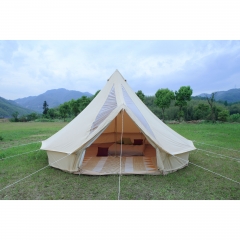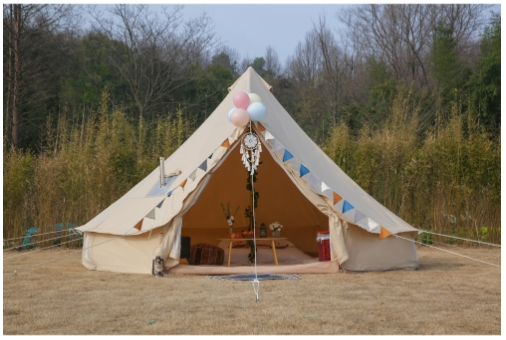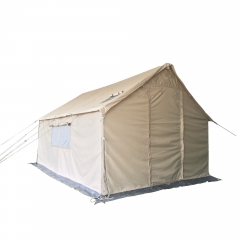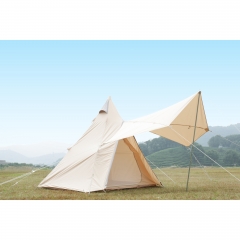 Chinese tent manufacturers
Chinese tent manufacturers will share with you how to choose an outdoor tent and provide you with some references.
The type of tent-we needs to clearly understand the type of tent and make the worst plan for the environment of the destination, so as to choose the suitable
outdoor winter party tent.
Horizontal support tent: also called "triangular tent".
Herringbone brackets are used at the front and rear, and the middle frame is connected by a horizontal rod. The inner tent is supported and the outer tent can be used. The characteristic of this tent is that it has a large net space. The horizontal bracket tent is the most common tent-style in the early days, and the comfort is not high.
Dome tent: also known as yurt style, double ring tent.
It adopts double rod cross support, which is easy to disassemble and assemble. It is currently the most popular style on the market. Compared with scaffold tents, the space inside the dome tent is more spacious and suitable for 2 people or more. The dome tent is light in weight and easy to install, suitable for field camping in most environments. However, the stability of the dome tent is not very good in areas above 4000 meters in the poster, or in areas where strong winds and snowstorms are possible.
Single-ring tent: The single-ring tent is very light, has enough space for interaction, and is easy to set up. The shape of the single-ring tent is sleek and can deflect the wind direction.
Therefore, single-ring tents are mostly suitable for use in high latitudes and high altitude areas that may encounter wind and snow, and are one of the main forms of "alpine tents". However, the space of single-ring tents is smaller than that of double-ring tents, and most of them are single tents.
Passage tent: also known as "boat bottom tent", after being propped up, it looks like a boat turning back.
The top of this tent has three-ring structures, each side has a smaller ring top, and there are entrances on both sides. The characteristic of this tent is that the internal space is very large, the middle of which is the main room, and the two ends are halls. Channel tents are mostly multi-person tents, which can house three or more people at the same time. The design pays attention to the windproof streamline, which is also one of the common tent styles. However, tunnel tents are generally large in size and not suitable for hiking, and more suitable for driving. (Of course, if they are separated and carried by multiple people)
Grid dome tent: also called a hexagonal tent, it adopts three-pole or four-pole cross support, and some adopt the six-pole design.
The grid dome tent is strong, easy to carry, easy to build, and dismantle. Its unique curved interlocking pillars make it stronger and more stable, which is a common style of "mountain type" tents. The net-format dome tent has better usable space and can form multiple cabins, suitable for 2 to 3 people.
Self-opening tents: also called "automatic tents", mostly leisure tents.
This kind of tent is mainly suitable for family gatherings, outings, picnics, and other purposes. There are no crowd restrictions, and there are various spaces and sizes. The foldability of the self-opening tent is a major feature of it. It can be quickly opened and closed. After being stowed, it is usually in the shape of a pie, which is very suitable for being placed in the trunk of a car.
According to the season of use, outdoor tents can be divided into three quarters and four seasons.
Three-season tents: usually lighter, generally used in milder climates in spring, summer, and autumn. Three-season tents can usually perform well in wind and rain, but the design characteristics also determine that they are generally difficult to cope with excessive snowfall. So it is not suitable for use in high altitude, high latitude areas or in winter. In addition, the three-season tent has another characteristic-it has a certain ventilation design, and is generally designed as a double-layer tent, divided into internal and external tents. The internal and external accounts can be used separately to meet the different needs of spring, summer, and autumn. It is worth noting that most double-ring tents and tunnel tents are three-season tents.
Four-season tents: For stronger four-season tents, 1 or 2 support poles are usually added to make the support system able to withstand stronger wind or thicker falling snow. It is suitable for areas that may encounter wind and snow in winter or at high altitudes and high latitudes. Most of the four-season tents have adopted a rounded dome design. The dome avoids the appearance of a flat surface on the top of the tent and is not easy to accumulate snow, and this design can better resist wind and provide a sufficiently high internal space.
Some four-season tents can also be converted into three-season tents. The adjustment method is usually to remove 1 or 2 support rods from the support system of the tent and provide detachable ventilation parts in the design, which can be removed in mild weather Or open to enhance ventilation.
Of course, these four-season accounts are also suitable for relatively mild weather conditions. It's just the weight of their extra support rods that makes them heavier than the three-season account. If you have a strong carrying capacity, or you just occasionally need to explore high altitude and high latitude areas, then it is recommended that you choose a four-season account.
Four-season tents: For stronger four-season tents, 1 or 2 support poles are usually added to make the support system able to withstand stronger wind or thicker falling snow. It is suitable for areas that may encounter wind and snow in winter or at high altitudes and high latitudes. Most of the four-season tents have adopted a rounded dome design. The dome avoids the appearance of a flat surface on the top of the tent and is not easy to accumulate snow, and this design can better resist wind and provide a sufficiently high internal space.
Some four-season tents can also be converted into three-season tents. The adjustment method is usually to remove 1 or 2 support rods from the support system of the tent and provide detachable ventilation parts in the design, which can be removed in mild weather Or open to enhance ventilation.
Of course, these four-season accounts are also suitable for relatively mild weather conditions. It's just the weight of their extra support rods that makes them heavier than the three-season account. If you have a strong carrying capacity, or you just occasionally need to explore high altitude and high latitude areas, then it is recommended that you choose a four-season account.
 Chinese tent manufacturers will share with you how to choose an outdoor tent and provide you with some references.
Chinese tent manufacturers will share with you how to choose an outdoor tent and provide you with some references.


